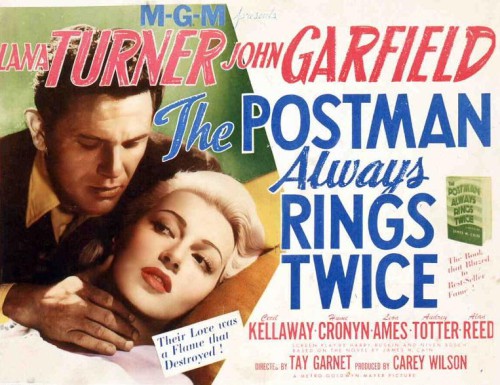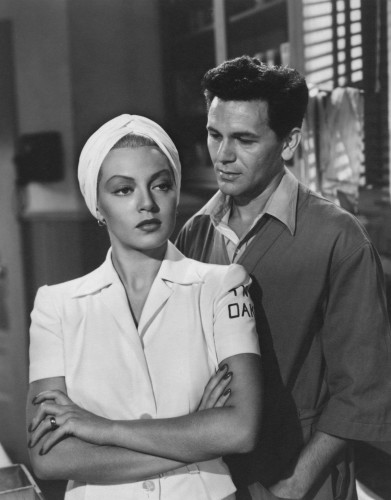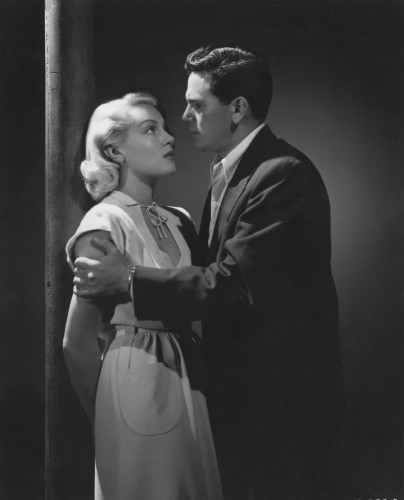
“They threw me off the hay truck about noon.” So opens James M. Cain’s 1934 noir novel of rough sex, murder, double-cross, and the hand of fate. Things were not so sunny in California in 1934. The Depression was in in full force, and grifting was a fallback trade. James M. Cain had already participated in the butchery of World War I and a life as a journalist. He was raised among the Eastern establishment but always had a contrary streak, especially in using the common vernacular of writers Mark Twain and Hemingway. After several failed novels he found his path with a ripped-from-the-headlines story of the husband-murder case of lovers Lee Snyder and Henry Gray. And like fellow crime writer Raymond Chandler, he found the deepest shadows in the bright lights of Southern California. First of his crime novels was The Postman Always Rings Twice, a best-seller. It was followed by Double Indemnity and Mildred Pierce. Classic movies were made of all three books, though in reverse order of their publication. The Postman Always Rings Twice took the longest to get to the screen. It was the darkest of the three.
This post is part of the Classic Movie Blog Association Words! Words! Words! Blogathon
RKO was the first studio eager to make Postman. Knowing that the sex and the story would cause problems with the censors at the Production Code Administration, production head Merian C. Cooper submitted a synopsis to the PCA in 1934. Their answer was brief: the story was “…definitely unsuitable for motion picture production.” Warner Brothers and Columbia followed suit, but abandoned the idea after getting the same message from the PCA. But then on March 9, 1934 only hours after Columbia had abandoned their plans to move forward on an option; Eddie Mannix bought the rights to make the film at MGM. This despite the PCA’s pleas to MGM to drop any plans of making a movie of the book it considered, “unwholesome and thoroughly objectionable.” MGM shelved it, although it was then made in France in 1939 as, Le Dernier Tournant (The Last Turn). Then after a string of successes at different studios of the Cain stories; Double Indemnity and Mildred Pierce, MGM revived plans and developed different treatments and scripts and submitted these to the PCA in the 1940s. It took the end of World War II and the rising genre of film noir for the PCA to approve a temporary script in May 1945. From there it would go on the fast track as a star vehicle. This would be no B-film noir.
Cain’s novel uses few descriptive passages. Cora is introduced with, “Except for the shape she really wasn’t any raving beauty, but she had a sulky look to her, and her lips stuck out in a way that made me want to mash them in for her.” With book and film, there’s no chemistry in their narrator Frank and Cora’s encounter at the Twin Oaks Tavern, “a sandwich joint like a million others in California…with a house part…and a filling station…and a half dozen shacks that they called an auto court.” The chemistry soon heated up. In the film this was helped by the near perfect casting of Lana Turner as Cora and John Garfield as the drifter Frank Chambers, the newly hired help. Cecil Kellaway played the witless husband and Twin Oaks owner Nick Smith (Nick Papadakis in the book). Tay Garnett directed.
Lana Turner makes her entrance in the movie bare legs first. She’s dressed in white shorts and a white halter top. Janine Basinger describes the scene as “…one of the iconic showstoppers in modern motion picture history.” Although in the first minutes of the scene Garfield as Frank and Turner as Cora play cat and mouse, there’s no doubt in the mind of the audience that sparks are going to fly, and soon.

Irene Lentz Gibbons designed the costumes for Lana Turner. Irene designed an almost all-white wardrobe for Lana, wanting to emphasize her sun-tanned California look in her crisp white Twin Oaks uniform. Irene also wanted to help create that heavenly vision of Lana first coming down the staircase. The contrast of her platinum blond hair and white outfits with John Garfield’s darker complexion makes for the perfect film noir atmosphere. As Lana was described in this film, “a black widow in white shorts.” Tay Garnett claimed credit for having Lana dressed in white, along with producer Carey Wilson, stating it helped make her look less sensuous in trying to get past the censors. But in the book Cora starts out from the beginning in a white Twin Oaks uniform. The only exception to her all white wardrobe is one black dress Irene designed.

A hot affair develops between Frank and Cora, and when the unsuspecting Nick drives to the City to get a new sign for Twin Oaks, Frank and Cora decide to skedaddle. But they are hitchhiking, walking really, and Cora gets cold feet after eating dust for several miles. But she’s had time to think, why leave with nothing? She berates Frank for his satisfaction at being a drifter, “I want to be somebody, “she says. So they go back to Twin Oaks, and after they get back, and she sees Nick driving home drunk, she knew she could be somebody, and have Frank, and Twin Oaks – and all it would take is for Nick to have a deadly accident. And maybe that could be helped along. But this is James M. Cain’s darkest novel. And this is classic film noir, where even the best made plans take ill-fated detours.

Cora: There’s one thing we could do to fix everything for us.
Frank: What? Pray for something to happen to Nick?
Cora: Something like that.
Frank: Cora!
Cora: Well you suggested it yourself once, didn’t you…
Frank: But they hang you for a thing like that.
And accidents did start happening to Nick. Until the last one killed him. Only the accidents happened to Frank and Cora too. Then there was a trial for murder. And then the circumstances had the lovers accusing each other. Courtroom shenanigans and a clever lawyer had Cora and Frank walking free. But the DA is not satisfied. And distrust has set in, and a blackmailer prowls, and another female lurks with her cats – big cats.
There is no happy ending in The Postman Always Rings Twice. Even this fact didn’t satisfy the censors in allowing the original story to be filmed until twelve years after it was published. Frank Chambers ended up paying twice for his crime. Although the lines were never meant for this book or this movie, Walter Neff’s statement from Double Indemnity, is apt, “I killed for money. And for a woman. I didn’t get the money and I didn’t get the woman.” The title of The Postman Always Rings Twice the book and the film is allegorical – with the second ring of the postman (as messenger) delivering the fate to Cora and Frank they had escaped with the first ring.
Views: 514
